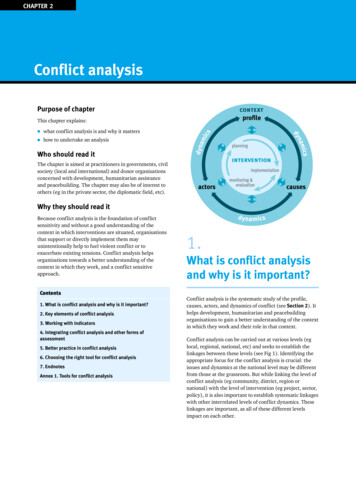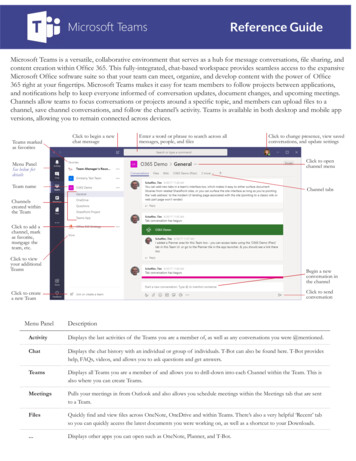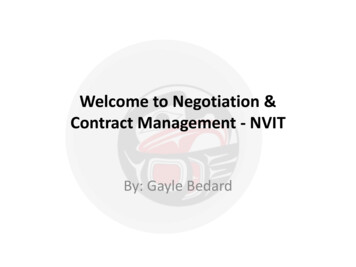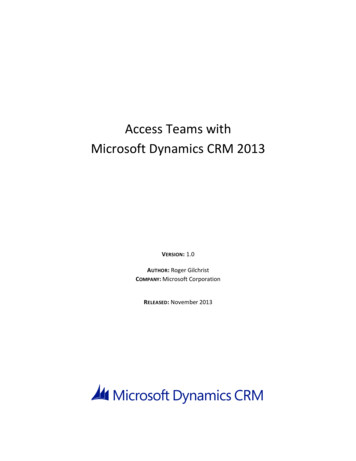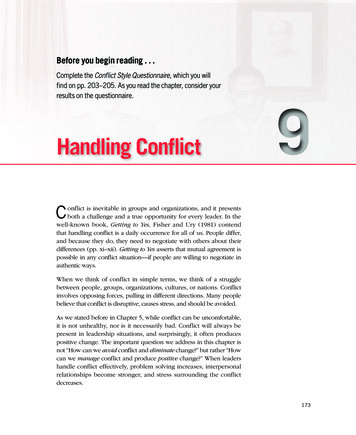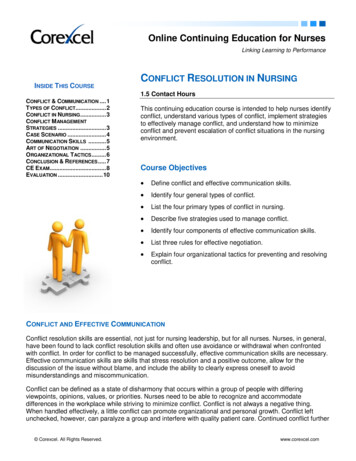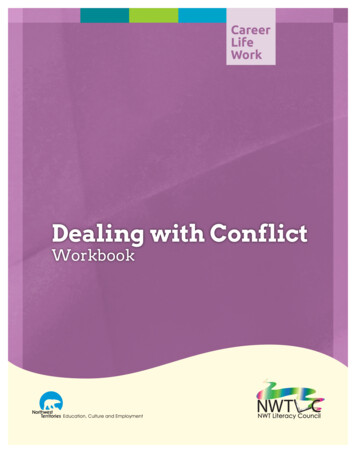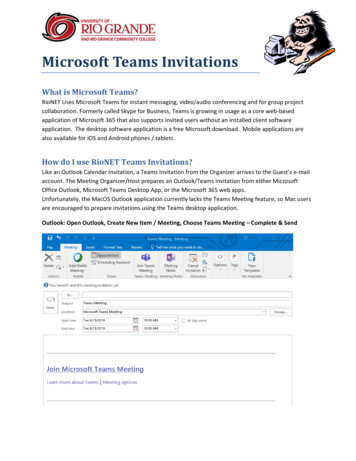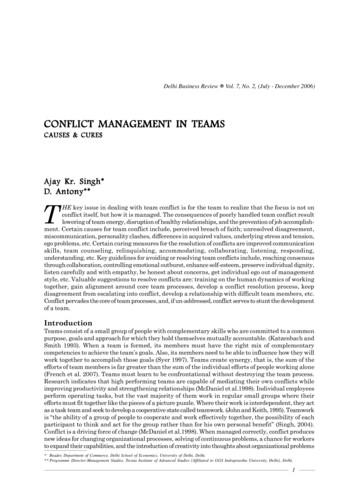
Transcription
Delhi Business Review X Vol. 7, No. 2, (July - December 2006)CONFLICT MANAGEMENT IN TEAMSCAUSES & CURESAjagh*Ajayy KrKr. SinSingh*D. Antony**Antony**THE key issue in dealing with team conflict is for the team to realize that the focus is not onconflict itself, but how it is managed. The consequences of poorly handled team conflict resultlowering of team energy, disruption of healthy relationships, and the prevention of job accomplishment. Certain causes for team conflict include, perceived breach of faith; unresolved disagreement,miscommunication, personality clashes, differences in acquired values, underlying stress and tension,ego problems, etc. Certain curing measures for the resolution of conflicts are improved communicationskills, team counseling, relinquishing, accommodating, collaborating, listening, responding,understanding, etc. Key guidelines for avoiding or resolving team conflicts include, reaching consensusthrough collaboration, controlling emotional outburst, enhance self-esteem, preserve individual dignity,listen carefully and with empathy, be honest about concerns, get individual ego out of managementstyle, etc. Valuable suggestions to resolve conflicts are: training on the human dynamics of workingtogether, gain alignment around core team processes, develop a conflict resolution process, keepdisagreement from escalating into conflict, develop a relationship with difficult team members, etc.Conflict pervades the core of team processes, and, if un-addressed, conflict serves to stunt the developmentof a team.IntroductionTeams consist of a small group of people with complementary skills who are committed to a commonpurpose, goals and approach for which they hold themselves mutually accountable. (Katzenbach andSmith 1993). When a team is formed, its members must have the right mix of complementarycompetencies to achieve the team’s goals. Also, its members need to be able to influence how they willwork together to accomplish those goals (Syer 1997). Teams create synergy, that is, the sum of theefforts of team members is far greater than the sum of the individual efforts of people working alone(French et al. 2007). Teams must learn to be confrontational without destroying the team process.Research indicates that high performing teams are capable of mediating their own conflicts whileimproving productivity and strengthening relationships (McDaniel et al.1998). Individual employeesperform operating tasks, but the vast majority of them work in regular small groups where theirefforts must fit together like the pieces of a picture puzzle. Where their work is interdependent, they actas a task team and seek to develop a cooperative state called teamwork. (John and Keith, 1995). Teamworkis “the ability of a group of people to cooperate and work effectively together, the possibility of eachparticipant to think and act for the group rather than for his own personal benefit” (Singh, 2004).Conflict is a driving force of change (McDaniel et al.1998). When managed correctly, conflict producesnew ideas for changing organizational processes, solving of continuous problems, a chance for workersto expand their capabilities, and the introduction of creativity into thoughts about organizational problems* Reader, Department of Commerce, Delhi School of Economics, University of Delhi, Delhi.** Programme Director-Management Studies, Tecnia Institute of Advanced Studies (Affiliated to GGS Indraprastha University, Delhi), Delhi.1
Ajay Kr. Singh and D. Antony(Bowditch & Buono, 1997). The consequences of poorly handled team conflict result lowering of teamenergy, disruption of healthy relationships, and the prevention of job accomplishment. The key issue indealing with team conflict is for the team to realize that the focus is not on conflict itself, but how it ismanaged. The idea behind managing conflict is not to reduce conflict, but to handle it in a constructivemanner (Rayeski & Bryant, 1994). Too often, conflict is smoothened over by a team leader and is notresolved; the end result is a building up of resentment between team members that deteriorates theteam’s performance level (Wisinski, 1995).Team Conflict“Conflict” is a word that causes a great degree of discomfort, anger, frustration, sadness, and pain topeople. In the workplace, a simple disagreement between team members, if unresolved, may escalateinto avoidance, inability to work together, verbal assaults, and resentment. In the worst cases, it mayalso lead to hostility and eventual separation from the organization. Therefore, it is important that theconflict be resolved as soon as possible. (Team Problem Solver). Conflict is a struggle to resist orovercome; a contest of opposing forces; strife; battle; a state or condition of opposition; antagonism;discord; clash; collision. Conflict arises from a multitude of sources that reflect the differences inpersonality, values, ideologies, religion, culture, race, and behavior. It also arises from simplemisunderstandings. As we have expanded collaborative concepts within our workplaces, we havedramatically increased the number of human interactions where one’s opinions can be heard. Newteams, for example, may find themselves in conflict as discussions lead them into uncharted waters(Peter B. Grazier).Source of ConflictUse of common resources-In the company sales offices where the institutional and retail sales teamscoexist, they share the same godown or C & F (Clearing & Forwarding) agent, billing system, commercialteam, delivery team and the accounting department. Both the teams want a priority treatment to theirown customers or channel members. They try to expert pressure on billing people and delivery staff toexecute their orders immediately even if it may result in more cost to the company by way of smalldelivery loads or multiple consignments towards the same geographical area. The commercial team,always under pressure to reduce operating costs, tries to optimize the use of space in any carrier andclub the supplies in one direction. Obviously, this leads to some unexecuted orders at any point of time,leading to friction in the sales teams. This problem magnifies at the sales closing stage every monthwhen all the sales team members extract orders from each channel partner or customer to fulfill theirtargets. Each one of them wants that at any cost, the orders procured by him should be billed anddelivered before the sales is closed by the commercial department. Though this situation arises evenwhere there is only one type of sales team, somehow it is more evident where both the teams areworking. Probably, this is due to the existence of two team leaders, which gives a feeling of ‘our’ salesand ‘their’ sales in the two groups (Zameer 2005).Team conflict can be a source of excellence, quality and creativity. However, occasions can arise whereconflict in teams becomes interpersonally destructive and leads to lowered effectiveness. This occursespecially where the conflict takes on a personal quality, which results in team members attacking oneanother, or denigrating each other’s skills, abilities or functioning in some way. This is unhealthy bothfor the individuals, concerned and for the team as a whole. Interpersonal conflicts are often not causedby the personalities of the individuals involved, but by work role or organizational factors. There is atendency to attribute to individual’s problems, which may be due to factors in the work environment.The causes of interpersonal conflict in teams can often be due to broader organizational problems suchas lack of structure, inadequacy of resources, poor organizational climate or inappropriate organizationalstrategy. Some of the differences between team members can be due to characteristic styles of workingwhich, while valuable in themselves, may cause some mutual antagonism or friction. Sometimes2
Delhi Business Review X Vol. 7, No. 2, (July - December 2006)conflicts between individuals within team cannot be dismissed as due to role, organizational, or teampersonality-type factors. Irritations do arise and difficulties do have to be worked through (West 1996).Causes of Team ConflictConflict begins due to poor communication, seeking power, dissatisfaction with management style,weak leadership, lack of openness, and change in leadership (N.S.B.A. 2007).I. Eight Causes of ConflictConflict may stem from a variety of causes, and understanding them is the first step in dealingwith it effectively. Following are the most common reasons for conflict (Team Problem Solver).1. Perceived breach of faith and trust: There is a perceived breach of faith and trust betweenindividuals. When one puts faith and trust in another, and that confidence is broken, it can createan emotional response that elevates to conflict. A trusting relationship leads to feelings of confidenceand security. A breach of trust unleashes our strongest emotions that frequently lead to conflict.2. Unresolved disagreements: Disagreements are normal. When they are left unresolved, however,the associated feelings and emotions will remain in force, at least at some level. When anothersituation brings this disagreement back to the forefront, these suppressed emotions can erupt withforce, usually far in excess of those associated with the original disagreement. Therefore, it iscritically important to resolve disagreements as soon as possible and not let them continue.3. Miscommunication: The ability to communicate is one of our most commonly used skills. Wesometimes use words to communicate do not always clearly state the picture in our minds. Whenthis occurs, errors often result that lead to frustration. Depending on a multitude of factors (stresslevel for one), the error sometimes results in conflict if neither person is willing to accept responsibilityfor it.4. Personality clashes: We are all different. Experts say that our personalities are geneticallydetermined resulting in different sets of preferred behaviors. The following table speaks thePersonality Clashes of two different types of people.These natural sets of differences are some of our greatest strengths as individuals and teams;however, they are also sources of conflict.5. Differences in acquired values: Our values are the beliefs we hold that help us to makedecisions about what is right or wrong, good or bad, and normal or not normal. Our values comefrom parents, siblings, friends, mentors, coaches, teachers, books, churches, movies, television,music and life in general. No two people ever have the same life experience, so we ultimately havedifferent sets of values and beliefs that guide our decisions and behavior. So, value system is astrong driver of behavior and a frequent source of conflict in our lives and in our teams.6. Underlying stress and tension: Our lives today place enormous demands on our time andenergy. But frequently those demands exceed our capacity to deal with them. Never the less, wecome to work and attempt to function normally with our team members. Too often, however, thisunderlying stress surfaces at the slightest provocation, and we find ourselves in conflict.7. Ego problems: Ego is another strong driver of human behavior and decisions. Ego wants us tobe “right,” and moves people into defending their position, sometimes unreasonably. One of thequickest ways to diffuse an argument or conflict is to admit one’s mistakes. At a minimum, moveout of ego and attempt to see the situation from the other person’s point of view.3
Ajay Kr. Singh and D. Antony8. Combinations of the above: Conflict situations are rarely clear-cut, single-source events.Usually, they are a combination of the factors listed. One may have a disagreement that stemmedfrom a miscommunication.II. Nine Causes of ConflictNine possible causes of conflict include: Conflict with self, needs or wants are not being met, valuesare being tested, perceptions are being questioned, assumptions are being made, knowledge isminimal, expectations are too high/too low, personality, race, or gender differences are present(N.S.B.A., 2007).Team Conflict Resolution MethodsI. Levine’s Resolution ModelDrawing on his extensive experience, Levine (1998) shares a model for conflict resolution. Theseven steps of his resolution model are discussed below:1. Develop an Attitude of Resolution: The above process will not work unless one first holdscertain values that make up an attitude of resolution. Levine discusses values such as believing inabundance, being creative, and relying on feelings and intuition.2. Tell Your Story: Telling your story is listening to all stories, including yours. It is aboutunderstanding and being understood. Looking for “the truth” in their story is not as important ashonoring their authenticity, and understanding “their truth.”3. Listen for a Preliminary Vision of Resolution: Listening for a preliminary vision ofresolution is thinking about a resolution that honors all concerns in the situation. It is aboutshifting from the desire to win, and get ones way, to a vision that everyone can buy into.4. Get Current and Complete: Getting current and complete is saying what usually goes unsaid.It demands saying difficult, sometimes gut-wrenching things, thereby escaping from the emotionalprisons that keep us locked in the past.5. See a Vision for the Future: Seeing a vision for the future means reaching a generalunderstanding of the resolution- a foundation of a new agreement. It requires letting go of thedesire for what you know will not work and focuses on what will.6. Craft the New Agreement: Crafting the new agreement adds the specifics. The key point is tohave a map or formula for the dialogue that will maximize the potential for everyone to obtain hisor her desired results.7. Resolution: Resolution is moving back into action. With a new agreement, and a quiet, clearmind about the past, one can freely move forward.II. McDaniel’s Team Mediation ProcessMcDaniel et al. (1998) offer a step-by-step mediation process for teams dealing with conflict. Thismediation process provides the work team with skills and structure for mediating their own disputes.Following are four requirements for effective implementation of this team mediation process.1. Communication Skills: The first requirement is for each team member to be able to learn theappropriate communication skills and the overall mediation process. These communication skillsinclude learning to confront others, listening to other’s concerns, acknowledging opposingperspectives, responding appropriately, and committing to a plan of agreed action.4
Delhi Business Review X Vol. 7, No. 2, (July - December 2006)2. Individual Certification: The next requirement is the individual certification of competencyfor each member’s use of the mediation skills and understanding of the process. Competency ratingsare used in other areas of skill, such as technical competencies, and are appropriate measures ofinterpersonal conflict skill usage.3. Environment: The third requirement for effective mediation implementation is an environmentin which the team is empowered to solve their own conflicts. The team must have the authority tocreate and establish its system of mediation. For example, the team begins to establish the systemby brainstorming over the ideas of conflict, the negative results, and the positive outcomes for theteam. Within this process, the team defines agreed upon team values, expectations, and procedures.This process is referred to as setting the path or boundaries of acceptable behavior for the team.4. Collectivity: The team members are expected to recognize and resolve conflicts collectively.Team self-reliance for conflict resolution ranges from situations involving only two members, tocomplex situations, involving disagreement among all team members. The mediation processprovides the team with the ability to handle conflict at both extremes.III. Rayeski and Bryant Team Resolution ProcessTeam Resolution Process is defined by Rayeski and Bryant (1994) as, “the process by which anindividual, when provided an opportunity for improvement, accepts and makes a conscious, personalcommitment to act upon this opportunity to enhance his/her performance”. Rayeski and Bryant’sprocedure includes the following three steps for addressing an escalating conflict:1. Collaboration: Initially, as conflict arises, it should be handled informally between the twoteam members in a private setting. This method of collaboration provides the opportunity for selfcorrective behavior by the individual, without the need for any formal disciplinary action.2. Mediation: The second step is mediation. If the situation escalates, a mediator is brought intothe dispute to assist both sides in reaching an agreement. This mediation step is needed when anissue between individual members becomes disruptive to the team and collaboration attempts areineffective. Efforts are made to relate the problem to customer and/or organizational needs. Thesuccess of this step relies on the neutrality of the mediator and the degree to which the team truststhis individual.3. Team Counseling: The third step is team counseling. If efforts of collaboration and mediationfail, this is the final step for resolving an escalating team conflict situation. Team counseling isheld at a team meeting, with all members of the team present. The issue is presented along with allthe facts surrounding the disagreement.IV. Wisinski’s Team Conflict Resolution SkillsOnce a person enters into a team membership, he or she is entering into an interdependentrelationship. There is a sense that a person is giving up one’s individuality, yet the contribution tothe team produces an end result greater than that achieved by individual effort. Wisinski, (1995)proposes the use of the following six skills required for team membership to maintain strong teamrelationships needed for addressing conflict.1. Participation: Participation indicates that a member is involved in the team in a balancedmanner; the member is neither too withdrawn, nor overbearing or dominant. Each member isaware of this balance and helps others to maintain their respective balance.2. Claiming: There is a need for individual members to claim their ideas. For example, whenoffering an alternative solution for a problem, the member is prepared ahead of time and provides5
Ajay Kr. Singh and D. Antonythe necessary perspective on what this means for the team as a whole. In addition, the member isable to defend his or her view with logic rather than emotion.3. Relinquishing: Relinquishing is the ability of a team member presenting his or her personalopinion to withdraw it if it fails to gain the support of the team. The member relinquishes theposition in favor of a direction agreed upon by the entire team.4. Evaluating: Evaluating is the responsibility of each member to offer feedback stating anyimprovements or failures for the work of the team.5. Healthy Environment: Relationships are detrimental to the process of managing conflictproductively. Each member is responsible for maintaining supportive, healthy relationships withinthe team. There is a strong need placed on the individual to manage conflict between other teammembers.6. Task Accomplishment: Task accomplishment is the responsibility of a team member tounderstand what items and tasks they are responsible for in a functioning team role. This includesknowing when tasks need to be completed and the steps involved to complete each task.V. Drinka’s Conflict Resolution Technique (Conflict as a Measure of Team Development)The ability of a team to resolve conflict is a valid measure of team development. Conflict and chaosare central elements to the development of teams; therefore, conflict is an appropriate indicator ofteam development. Many teams function in unstable environments, plagued with unanticipatedproblems. Therefore, there is a strong need for teams to progressively confront conflict in order toextend team growth beyond the early developmental phases. Drinka, (1994) identifies the followingcommonly used styles of conflict resolution.1. Coercing: Coercing is a process in which groups use confrontational tactics, such as argument,use of authority, or threat, to achieve the goals of each group regardless of the expense paid by theother.2. Withdrawal: Withdrawal is the process by which both parties involved in a disagreementpostpone or ignore the issue causing the conflict.3. Negotiation: Negotiation is the process by which both groups selectively ignore certain interestsin order to reach an agreement, thus achieving partial satisfaction for each side.4. Accommodation: Accommodation is the process by which one group neglects its own interestsby satisfying the needs of the other group involved.5. Collaboration: Collaboration is the process by which each party attempts to reach mutualsatisfaction by collectively confronting the conflict, recognizing the concerns of each group, andproblem solving.VI. Weiss’s Four Skills for Resolving ConflictIf team members are not mutually respective of one another and fail to harbor a willingness todisagree and resolve disputes, no method of team resolution is effective. Weiss (1997) indicates thefollowing four skills that team members are responsible for practicing in order to disagree on issueswithout creating consequences damaging to the team.1. Listening: The first skill is listening. For a person to listen effectively, he or she must cleartheir mind of all distractions and concentrate on the people’s words, as well as nonverbal gestures,6
Delhi Business Review X Vol. 7, No. 2, (July - December 2006)such as tone of voice, posture, and hand movements. Being a good listener, enables a person tounderstand the content and feeling of a disagreement, thus increasing the likelihood of reaching anagreement.2. Acknowledging: The second skill is acknowledging someone else’s position and feelings withina dispute. Acknowledgment assures each team member that they are not being misunderstood.3. Responding: The third skill is responding. A person responding with constructive feedback toanother person’s argument clarifies his or her points of contention, while offering an alternative forthat person to contemplate. It is noted that efforts should be made to avoid defensive responses.4. Resolving: The fourth skill is resolving remaining differences. First, the real problem is definedby looking for the direct cause of the dispute. Next, the problem is analyzed into segmented parts.At this point, each party suggests alternative solutions. Finally, working together, both partiesselect the most reasonable and acceptable solution.VII. Three Steps Cycle to Resolve Team ConflictAccording to McDaniel et al. (1998) conflict can be addressed through the following three-stepscycle of concern, vision, and action.1. Concern: The first step teaches the responsibility of both parties participating in a dispute tounderstand the other person’s concerns. This requires the understanding of the emotions, needs,and reasons behind the stated position of the opposition.2. Vision: The second step illustrates the importance of both parties envisioning one another’sview of a win-win solution for the team. Recognizing the perspective of the team as whole is acritical element when arriving at a fully accepted solution. This becomes a meeting point betweenthe two arguing parties.3. Action: The third step is a commitment by both disputing sides to take the appropriate actionsto ensure the particular conflict will not re-occur. These actions are stated by both parties, alongwith a prescribed method for mediating the problem, should it re-occur.VIII. Four Skills to Overcome Team ConflictResolving conflict constructively is the most critical of team skills. Without this ability, the teamcannot develop the trust and bonding that allows moving from the storming stage into peakperformance. Following are some notable skills to overcome Team Conflict (Strategos International).1. Communication Skills: Good communication skills prevent conflict or destructive escalation.Listening effectively is the other half of good communication. Team members must train theirminds to focus on words and message until the speaker finishes. Only then should they analyzeand formulate a response.2. Problem-Solving Skills: Problem-solving skills define a problem, gather information, analyzethe information, synthesize solutions, select the best solution, and implement it. These activitiesoccur in distinct steps and in an orderly and structured way.3. Avoiding Conflict: Other team skills have a collateral effect of avoiding conflict. Timemanagement prevents arguments about who does what and when. Cross training prevents boredomand prevents conflict over workloads. Facilitation controls meetings and reduces frustration overwasted time.7
Ajay Kr. Singh and D. Antony4. Conflict Resolution Skills: Intervention occurs when parties to a conflict are confronted. Inthe mildest form, a team member quietly and separately points out the situation to one or more ofthe individuals involved. Feedback is an effective conflict resolution technique. In feedback, oneindividual confronts another in a structured setting with a carefully crafted statement. It defusesanger and brings rationality to a discussion.IX. Seven Steps to Conflict ResolutionThe ability to resolve a conflict is a highly prized skill. Getting into conflict is easy, getting out of itis something else. The following Seven steps will give a direction on how to approach conflict (TeamProblem Solver).1. Develop an attitude of resolution: Take a deep breath and count to “10.” Think about theconflict and what gave rise to it. Instead of seeing oneself as a victim, think about his/her ownbehavior. Try to change once mental state from one of anger and confrontation to one of calm,inquiry, and resolution.2. Set the stage, plan your approach: After putting oneself in a better frame of mind (in step1), it is now time to plan his/her approach to the resolution. If one is still angry, find a safe placeand person with whom one can vent his/her anger and get some honest, objective feedback.3. Arrange a place and time to talk: Choose a time and a place convenient to both parties wherethey can focus attention on resolution. Sometimes it is useful to find an environment different fromthe setting where the conflict arose. For example, one might suggest a walk outside or sit at apicnic table.4. Tell your stories; gain an understanding of the issues: Covey (1994) in his book TheSeven Habits of Highly Effective People says, “seek first to understand, then to be understood.” Askthe person to relate his/her side of the conflict. Then sit back, and listen. Ask questions, and seekto understand why they see it that way without implying they are wrong. Restate the key pointsand ask the person if you have heard them correctly. This is a critical step, because it will tend todefuse hostility. Then tell them your story, and ask them to suspend judgment until you’ve finished.As these stories are being told, listen for a preliminary vision of resolution. There is a tendency torush in and resolve conflict before we ever have a real understanding of the underlying issues.Telling your stories and really listening will provide a framework for this understanding.5. Listen actively and with empathy: Active listening entails: looking directly at the person,making eye-to-eye contact, nodding occasionally (to indicate comprehension and agreement), sittingquietly, speaking only for clarification and summarizing their key points (to demonstratecomprehension). As a person tells his/her story and perceives he/she being heard, tension tends todecrease and real dialogue begins. Sometimes just the act of being heard is all that is necessary todefuse a conflict.6. Generate solutions and a shared, win-win vision of resolution: A good, win-win solutioncomes from a sense of fairness. It honors that there are elements of truth in each person’s story,and so the resolution should consider this. Brainstorm with the parties for ideas on how to resolvethe issue. Explore and be creative in searching alternatives.7. Test for satisfaction: Ask each party if the solution works for them. This again involvesactively listing to the response. If one party is not really satisfied with the outcome, but is notsaying so, then the conflict will probably arise again. Finding satisfaction releases tension andhostility.8
Delhi Business Review X Vol. 7, No. 2, (July - December 2006)Table 1: Seven Steps to Conflict Resolution (Team Problem Solver-19)Conflict ResolutionHow to Effectively Resolve a ConflictTo Resolve a ConflictWhat to say or do?Why?1. Calm yourselfTake a deep breath, say “relax”Clears thinking, models control2. Restore orderTake a “Time Out”Stops the fight, contains the damage3. Hear their stories“Help me understand your concern.”Gathers information, defuses tension4. Listen carefullyEye contact, don’t interruptHonors the need to be heard5. Generate solutions“How could we resolve this?”Moves from accusations to solutions6. Agree on a solution “Would this work for you?”Moves to resolution, brings closure7. Test for satisfaction “Are you sure this will work for you?” Assures clear communicationThe Key Guidelines for Avoiding and/or Resolving ConflictI. Reaching Consensus through CollaborationGroups often collaborate closely in order to reach consensus or agreement. The ability to usecollaboration requires the recognition of and respect for everyone’s ideas, opinions, and suggestions.Consensus requires that each participant must agree on the point being discussed before it becomesa part of the decision. Not every point will meet with everyone’s complete approval. Unanimity isnot the goal. The goal is to have individuals accept a point of view based on logic. When individualscan understand and accept the logic of a differing point of
Conflict begins due to poor communication, seeking power, dissatisfaction with management style, weak leadership, lack of openness, and change in leadership (N.S.B.A. 2007). I. Eight Causes of Conflict Conflict may stem from a variety of causes, and understanding them is the first step in dealing with it effectively.
